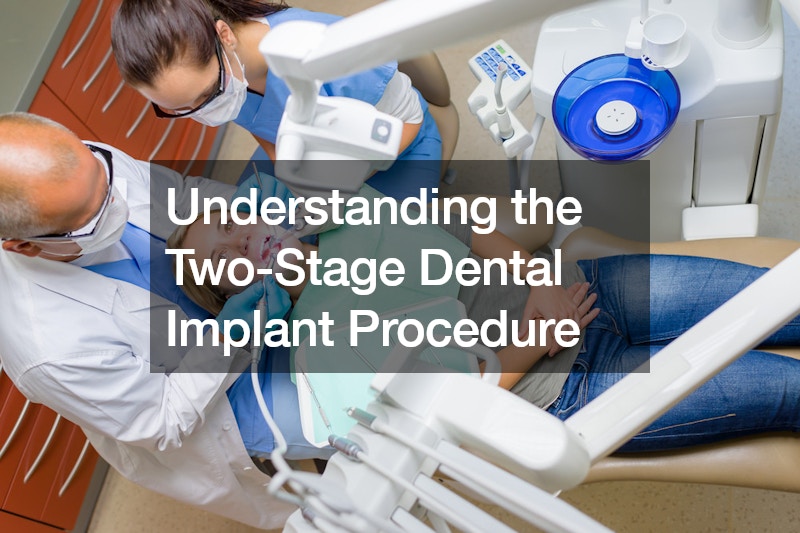
Dental implants have revolutionized tooth replacement options, providing a reliable and durable solution for individuals with missing teeth. Among the various approaches to dental implant placement, the two-stage method stands out for its effectiveness and success rates. In this comprehensive guide, we will delve into the intricacies of the two-stage dental implant procedure, shedding light on each step to demystify the process.
The Need for Tooth Replacement
Before delving into the specifics of the two-stage dental implant procedure, it’s essential to understand why tooth replacement is crucial. Missing teeth not only impact one’s appearance but also affect oral health and functionality.
Gaps in the dentition can lead to difficulties in chewing, speech impairments, and even jawbone deterioration over time. Tooth replacement options, such as dental implants, play a vital role in restoring both the aesthetics and functionality of the smile.
Initial Assessment and Treatment Planning
The journey towards dental implant placement begins with a thorough assessment and treatment planning process. During the initial consultation, the dentist evaluates the patient’s oral health, assesses the condition of the surrounding teeth and tissues, and discusses treatment goals and expectations. Comprehensive imaging techniques, such as X-rays and CT scans, are utilized to obtain detailed anatomical information, aiding in the precise planning of the implant placement procedure.
Bone Augmentation and Grafting
In cases where the available bone is insufficient to support dental implants, bone augmentation or grafting may be necessary. This additional step involves augmenting the existing bone structure through various techniques, such as bone grafts, sinus lifts, or ridge augmentation. By enhancing the volume and density of the jawbone, bone augmentation creates a solid foundation for successful implant placement, ensuring long-term stability and durability.
The Two-Stage Implant Procedure Unveiled
The two-stage dental implant procedure involves a meticulous series of steps aimed at ensuring the implant’s successful integration with the jawbone. The first stage begins with the elevation of a flap to expose the underlying bone. This surgical maneuver provides the necessary access to the bone, allowing the dentist to meticulously prepare it for the implant fixture. The bone is carefully drilled to accommodate the implant, a critical step that sets the foundation for a secure and lasting tooth replacement.
Once the bone is adequately prepared, the implant fixture is placed and covered with a slender cover screw. This screw serves as a protective barrier, covering the opening of the dental implant. The purpose of this cover screw is to shield the implant during the initial healing phase. It is a delicate yet crucial component in the two-stage procedure, playing a pivotal role in the implant’s integration process.
With the cover screw in place, the next step involves repositioning the elevated flap over the implant site and securing it with sutures. This careful closure of the surgical site promotes proper healing and protects the implant as the surrounding tissues recover. After this initial phase, a waiting period ensues, allowing the implant to integrate with the bone. This period is crucial for ensuring the stability and long-term success of the dental implant.
Upon the completion of the healing period, the second stage of the procedure commences. The implant is exposed by removing the cover screw, and a healing cap is introduced in its place. This cap facilitates the formation of the soft tissue architecture around the implant, creating an optimal environment for the final stages of the procedure. The tissues are repositioned around the healing cap, and another period of healing is allowed to ensure the proper maturation of the soft tissues.
After the second healing phase, the healing cap is removed, paving the way for the placement of the crown components. The crown, abutment, and implant crown are meticulously fitted onto the dental implant fixture, completing the restoration process. This final step results in a functional and aesthetically pleasing tooth replacement that mimics the natural structure and appearance of a healthy tooth.
The Benefits of Two-Stage Dental Implants
The two-stage dental implant procedure offers numerous advantages compared to alternative tooth replacement methods. Dental implants, unlike removable dentures, provide a permanent solution that seamlessly integrates with the jawbone, ensuring exceptional stability and preventing bone loss. Moreover, dental implants closely resemble natural teeth in appearance, sensation, and function, enabling patients to eat a varied diet and speak confidently. Unlike traditional bridges, which necessitate alterations to adjacent teeth, dental implants preserve neighboring tooth integrity, supporting overall oral health and longevity. Additionally, their longevity renders dental implants a cost-effective choice, potentially lasting a lifetime with appropriate upkeep.
In Conclusion
The two-stage dental implant procedure represents a sophisticated and effective approach to tooth replacement. From the initial assessment and treatment planning to the final placement of crown components, each step is crucial for ensuring the success and longevity of the dental implant. As individuals explore tooth replacement options, the two-stage method stands as a testament to the advancements in dental technology that have transformed the landscape of modern dentistry. By understanding the meticulous process involved in the two-stage method, prospective patients can make informed decisions about their oral health and embark on a journey towards a restored smile and improved quality of life.
.




